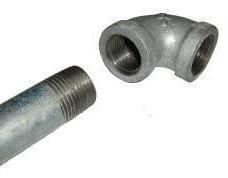 | ||
American National Standard Pipe Thread standards, often called national pipe thread standards for short, are U.S. national technical standards for screw threads used on threaded pipes and pipe fittings. They include both tapered and straight thread series for various purposes including rigidity, pressure-tight sealing, or both. The various types are each named with a symbol and a full name; examples of the symbols include NPT, NPS, NPTF, NPSC, and others.
Contents
Outside the United States, some US pipe threads are found, as well as many British Standard Pipe threads and ISO 7-1, 7-2, 228-1, and 228-2 threads.
Types
The various types are each named with a symbol and a full name, as follows:
Use
Threaded pipes can provide an effective seal for pipes transporting liquids, gases, steam, and hydraulic fluid. These threads are now used in materials other than steel and brass, including PTFE, PVC, nylon, bronze, and cast iron.
The taper on NPT threads allows them to form a seal when torqued as the flanks of the threads compress against each other, as opposed to parallel/straight thread fittings or compression fittings in which the threads merely hold the pieces together and do not provide the seal. The various types of pipe threads are designed for use both with or without thread sealants, as particular applications demand. The sealants, where used, are typically thread seal tape or pipe dope (sometimes plumber's putty). As the thread body is tapered (0.75 in/ft or 62.5 mm/m), a larger diameter keeps compressing into a smaller diameter and finally forms a seal (no clearance remains between the crests and roots of the threads because of the taper). This means that NPT fittings should be burr-free and lubricated using a lubricant like lubricating paste or thread seal tape. The use of tape also helps to limit corrosion on the threads, which otherwise can make future disassembly nearly impossible.
Commonly used sizes are 1⁄8, 1⁄4, 3⁄8, 1⁄2, 3⁄4, 1, 1 1⁄4, 1 1⁄2, and 2 inch, appearing on pipes and fittings by most U.S. suppliers. Sizes smaller than 1⁄8 inch are occasionally used for compressed air, while sizes larger than 2 inches are uncommon, due to the use of alternative methods of joining that are used with these larger sizes.
Specifications
NPT is defined by ANSI/ASME standard B1.20.1.
The taper rate for all NPT threads is 1 inch of diameter in 16 inches of length (3⁄4 inch per foot or 62.5 millimeters per meter) measured by the change of diameter (of the pipe thread) over distance of thread. The angle between the taper and the center axis of the pipe is tan−1( 1⁄32) = 1.7899° = 1° 47′ 24″.
Nominal Pipe Size (NPS) is loosely related to the inside diameter of Schedule 40 pipe. Because of the pipe wall thickness, the actual diameter of the threads is larger than the NPS, considerably so for small NPS. Pipe of other schedules with a certain NPS has different wall thickness, but the same outside diameter and thread profile as Schedule 40, so the inside diameter of the pipe is therefore different from the NPS.
Thread form
NPT and NPS threads have a 60° included angle and have a Sellers thread form (flattened peaks and valleys).
National pipe taper fuel (NPTF)
National Pipe Taper Fuel (NPTF), also called Dryseal American National Standard Taper Pipe Thread, defined by ASME B1.20.3, is designed to provide a more leak-free seal without the use of PTFE tape (often referred to by the popular brand name "Teflon") or other sealant compound. NPTF threads have the same basic shape but with crest and root heights adjusted for an interference fit, eliminating the spiral leakage path.
History
In 1864, William Sellers, the president of Franklin Institute, presented a standard for nuts, bolts, and screws. Out of this effort came the first United States Standard threads, including pipe threads. (See also Screw thread § History of standardization.)
